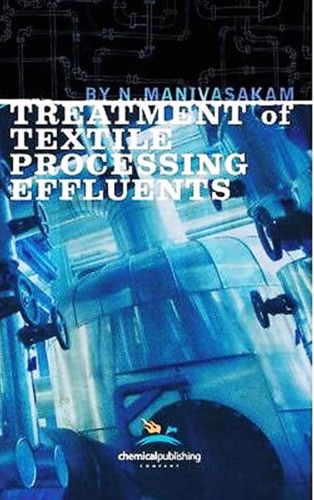

Most ebook files are in PDF format, so you can easily read them using various software such as Foxit Reader or directly on the Google Chrome browser.
Some ebook files are released by publishers in other formats such as .awz, .mobi, .epub, .fb2, etc. You may need to install specific software to read these formats on mobile/PC, such as Calibre.
Please read the tutorial at this link: https://ebookbell.com/faq
We offer FREE conversion to the popular formats you request; however, this may take some time. Therefore, right after payment, please email us, and we will try to provide the service as quickly as possible.
For some exceptional file formats or broken links (if any), please refrain from opening any disputes. Instead, email us first, and we will try to assist within a maximum of 6 hours.
EbookBell Team

4.4
22 reviewsCONTENTS Chapter - 1. Introduction; Chapter - 2. Characteristics of Cotton Textile Processing Effluents; Sizing; Desizing; Scouring; Bleaching; Mercerizing; Dyeing; Printing; Finishing; Combined Effluent; Chapter - 3. Treatment of Cotton Textile Processing Effluents Chapter - 4. Charactristics and Treatment of Synthetic Textile Processing Effluents; Process and Characteristics of Effluents; Treatment; Chapter - 5. Knit Fabric Finishing; Chapter - 6. Characteristics and Treatment of Woollen Textile Processing Effluents; Chapter - 7. Recent Trends in Textile Waste Water Management; Chapter - 8. Reduction of Pollution Load; Waste segregation; Recovery Substitution of Low-Pollution Load Chemicals; Judicious use of chemicals; Process changes; Economy in Water use; Chapter - 9. Recovery and Reuse of Sizes, Dyes and Other Chemicals; Recovery of PVA and other Sizing agents; Caustic soda Recovery; Recovery of Dyes; Reuse of Ozonated Dyebath; Recovery of Other Valuable materials; Recovery of Heat; Chapter - 10. Recycling and Reuse of Waste Water; Chapter - 11. Conservation and Reuse of Water; Part - II. TREATMENT METHODS; Chapter - 12 Treatment Methods - An Introduction; Chapter - 13. Preliminary and Primary Treatments; Screening; Equalization; Neutralization; Neutralization of Acidic Wastes; Neutralization of Alkaline Wastes; Coagulation; Coagulants; Auxiliary chemicals; Flocculation - Aids; Coagulation Merits Sedimentation; Floatation (Dissolved Air Floatation); Chapter - 14. Secondary Biological Treatment; Activated Sludge Process; Trickling Filtration; Aerated Lagoons; Oxidation Ponds; Anaerobic Digestion; Sludge Disposal; Removal of Interfering Substances; Chapter - 15. Tertiary Treatment; Multimedia Filtration; Chemical Coagulation; Chemical Precipitation; Disinfection; Ozonation; Activated Carbon Adsorption; Membrane Technology; Dialysis / Electro Dialysis; Evaporation; Chapter - 16. Advanced Methods for the Treatment of Textile Processing Waste Water; Advanced Oxidation Processes; Ozone Treatment; Adsorption; Membrane Technology; Dialysis / Electrodialysis; Ion Exchange; Evaporation; Crystallization; Freezing; Some Patented Technics for Color Removal; Bio-mass based Technologies; Cutting-EdgeTreatment Methods; Chapter - 17. Advanced Oxidation Processes; Non-Photo chemical Methods; Ozonation; Ozone/Hydrogen Peroxide Process; Fenton Method; Homogeneous Photochemical Oxidation Processes; Vacuum-UV Photo Oxidation; UV and Ozone; UV and Hydrogen Peroxide; UV, Ozone and Hydrogen Peroxide; Photo Fenton Method; Heterogeneous Photochemical Oxidation Processes; Chapter - 18. Ozone Treatment; Reactions of Ozone in Waste Water Treatment; Oxidative Reactions and Color Removal; BOD Reduction; Sludge Reduction; Advancements in Ozone Treatment; Chapter - 19. Activated Carbon Adsorption; Chapter - 20. Membrane Technology; Micro Filtration; Ultra Filtration; Nano Filtration; Reverse Osmosis; Disc and Tube Module; Membrane Bio-Reactors; Part - III. ANALYSIS OF TEXTILE PROCESSING EFFLUENTS; Chapter - 21 Purpose of Examination; Chapter - 22. Collection of Waste Water samples; Chapter - 23. Recording of Results; Chapter - 24. Analytical Methods - Important Notes; Chapter - 25. Parameters to be determined on Textile Processing Effluents; Chapter - 26. General Physico-Chemical Measurements; Chapter - 27. Measurement of Organic Pollution; Chapter - 28. Inorganic Constituents - Non Metallics; Chapter - 29. Inorganic Constituents - Metals; Chapter - 30. Miscellaneous Determination; Appendix; Index.�
Abstract: This book is written with the intention of providing textile processors with a clear picture of the effluents emerging from their industry, and to have a suitable treatment system that works efficiently and economically.�